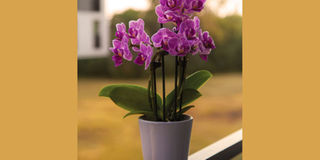Orchids – worth the effort

What you need to know:
Orchids are hard to grow but worth their price in the market.
Orchids are considered prized possessions among flowers, turning even the dowdiest of compounds into a posh-looking space.
Lillian Katiso, proprietor of Maua and More says these unique flowers are an amazing way to bring nature and character to any home. “They have an exotic beauty, blooming in a wide variety of colours; have a unique appearance and attractive patterns, colour combinations and interesting shapes. Some species are also fragrant,” she says.
Considered expensive flowers, Katiso says a few years ago, orchid dealers in Uganda sold them at about Shs500,000 and above. “Around 2019, the prices dropped to around Shs250,000 to Shs300,000. Today, at Maua and More, we have species ranging from as low as Shs50,000 and believe me the beauty is worth every cent ” she smiles.
However, the main reason why they are expensive is that a regular person cannot grow them from seed, as they are difficult to grow. Guido van Asten, an orchid enthusiast says while they can be propagated, he would not recommend it. “Large sized sympodial orchids such as Oncidiums can be propagated by division, but many cannot do it. In general, I wouldn’t divide an orchid as that sets it back and you may not have blooms on them for up to two years,” he says.
Katiso adds that for most vast orchid growers, the process starts in test tubes; in laboratories, under controlled conditions, which obviously costs more than a normal houseplant.
On the other hand, it is possible to mix and match them with other plants, mainly with bromeliads and Tillandsias. “That is because they can also be grown as air plants or in the same plant medium that orchids grow. They also have the same growing needs or requirements,” Katiso shares.
Many also believe that being exotic, orchids are of high maintenance but Katiso negates that saying they are not, if one knows the orchid type they are growing. “Start with selecting the right growth medium. For example, some species such as the Phaleanopsis, and Vandas have aerial roots, thus best grown in coarse material such as wood chips or bark of trees, charcoal or just wrapped in moss to help them hold moisture. Other orchid species such as Dendrobiums grow in semi-fine growing material such as coco peat or semi-fine wood chips, since their roots are a bit smaller,” she explains.
Van Asten adds that when growing these flowers, ensure they receive bright yet indirect light and daily watering. “This condition imitates their native habitats of jungles and forests and maintenance is very low. While sunlight plays a great role in blooming of orchids, midday or hot sun will scorch the leaves. Therefore, the ideal sunshine is that in the morning or late in the evening. The other thing is one ought to water them, more so on sunny days, and inspect for pests. Another condition is they need to be mounted on trees or wood as most orchids are epiphytes,” he shares.
Katiso adds that in most cases, the condition of your orchid’s roots determines the health of the overall plant. “You can tell that your orchid needs water, especially for those that grow in coarse material because when they are greyish or pale, a little water will enable them return to green. For others, the sign is when the potting material is tending to dry up,” she shares. It is also advisable to apply fertilisers only after the flowering period but stop when they are about to or start blooming.
Just as florists grow orchids, these can be grown at home and Katiso says the ideal conditions include:
Indoors, place it near a window to get some early morning sunshine or late evening,
If your ideal position is on a balcony or veranda, ensure it gets half-day sun and it is protected from hot afternoon sunshine
In the compound (garden), attach your plant to tree trunks. In pots, place it under taller plants that will provide them with dappled / filtered sunlight
Natural pest management
Without using pesticides, one can keep pests at bay by observing hygiene/ sanitation. “This is by removing old leaves, and planting the orchids in clean medium. Other methods include inspecting the plants regularly for any pests,” Katiso shares.
Pests
Snails and slugs are the major pests that affect these plants because they love the cold conditions. While it is not easy to prevent them, Katiso says one can do away with them by eliminating them manually, using slug pellets. “Some orchid growers say you put a saucer of beer so they crawl unto it and get drunk in it. However, I have not tried it,” she laughs.
Aphids are another menace, which can cause flowers to become mottled and distorted mainly among the Cymbidiums.
Scales also affect orchids and usually feed on the underside of orchid leaves.





